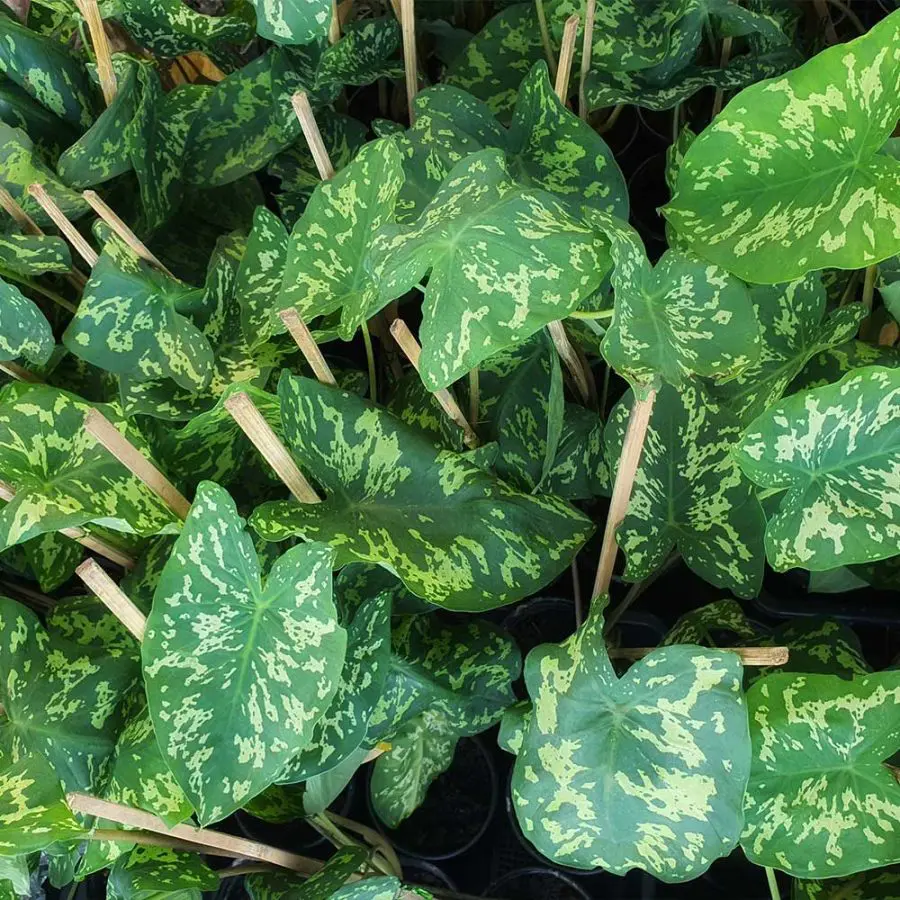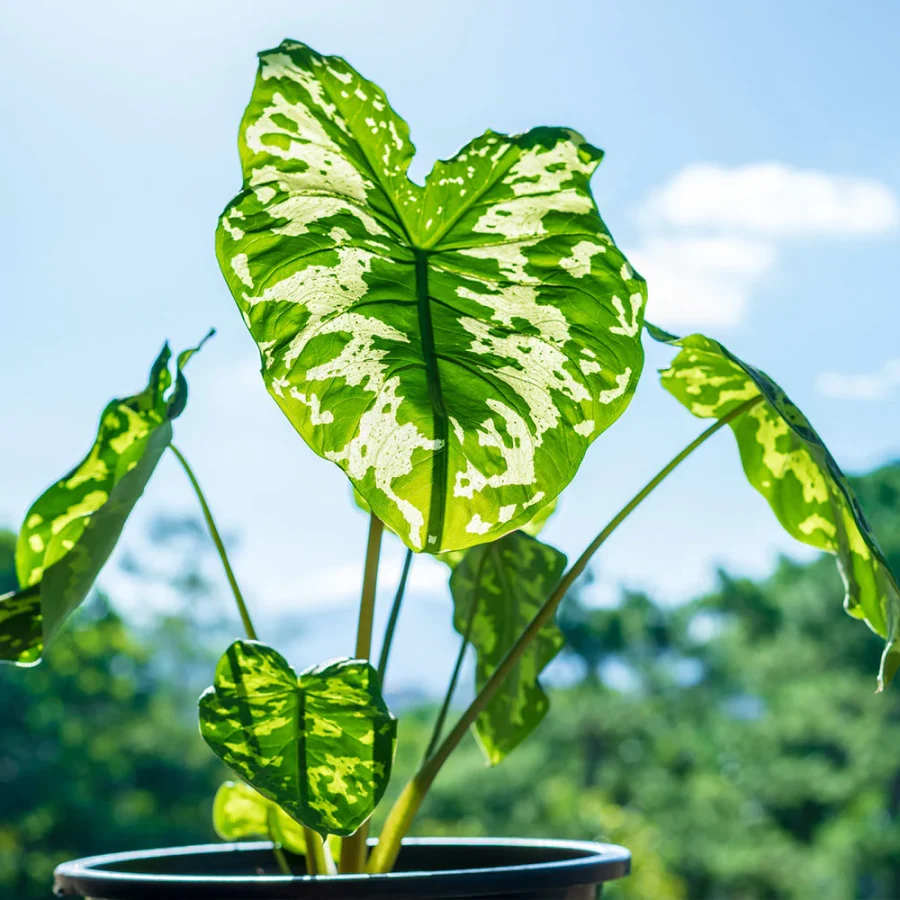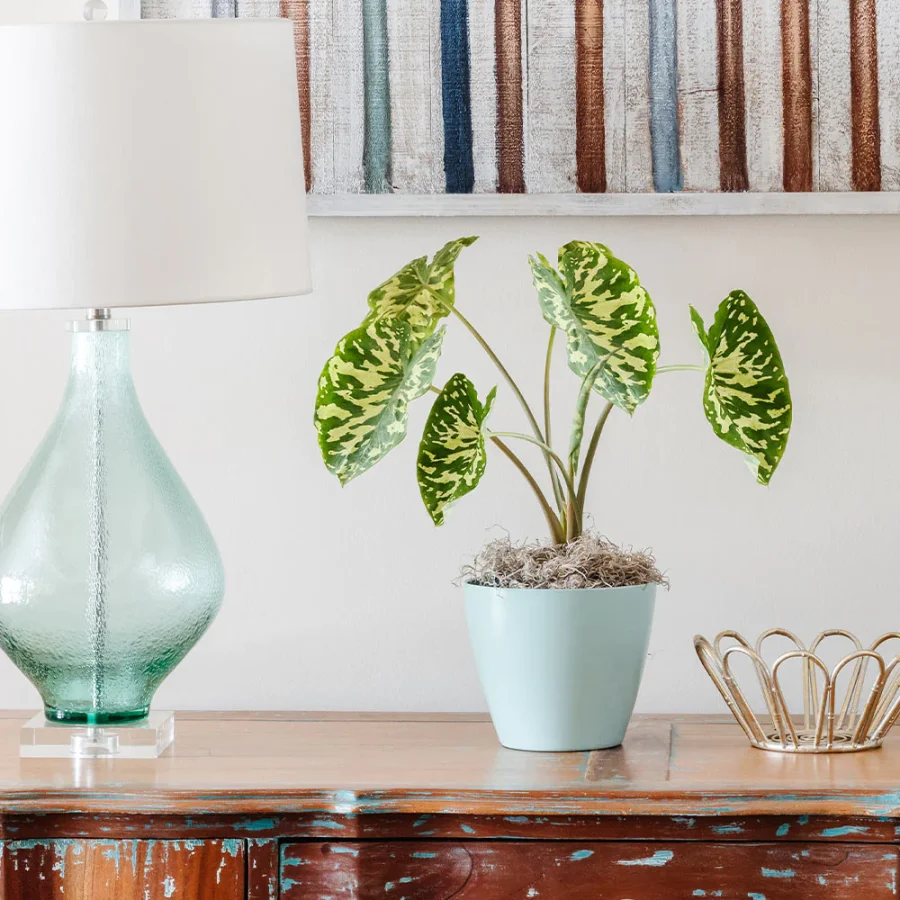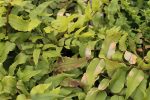This post contains affiliate links. If you buy something from one of our links we may earn a commission. Thanks
Looking for tips to keep your Colocasia indoor plants thriving? Check out our guide to Colocasia indoor care and learn how to give your elephant ears some love!
Colocasia, commonly known as the Elephant Ear Plant, thrives in moist, well-drained soil and partial shade. It’s known for its large, dramatic leaves that resemble elephant ears. Ideal for both indoor and outdoor settings, it needs regular watering and protection from frost for optimal growth.
Are you ready to bring some greenery into your home? Colocasia is also known as the elephant ear plant.
This plant, commonly known as the elephant ear plant, is not only visually stunning with its large, unique leaves, but it also has the added bonus of purifying the air in your home.
So whether you call it Colocasia or elephant ear plant we’ve got you covered!
Colocasia Indoor Care
Are you looking for a new houseplant to add to your collection?
Or maybe you’re already a proud owner of a Colocasia plant and you’re just wondering how to give it the best care possible?
Either way, you’ve come to the right place!
In this guide, we’re going to dive into the world of Colocasia indoor care and give you all the tips and tricks you need to keep your elephant ear plant happy and healthy.
So let’s get started, shall we?
What is Colocasia Indoor Care?
Colocasia indoor care refers to the practice of maintaining a healthy growing environment for the Colocasia plant, also known as the elephant ear plant, inside your home.
This includes providing proper light, temperature, water, and nutrients to support the plant’s growth.
Distinctive Heart-Shaped Foliage in Vivid Green Hues The Allure of Colocasia ‘Hilo Beauty’ Plants
Introduce a touch of the tropics to your living space with this exceptional houseplant!
Originating from the warm, tropical, and subtropical areas of Southeast Asia and India, the Colocasia ‘Hilo Beauty’ captivates with its striking, multicolored leaves.
Featuring deep blue stems and expansive, radiant green leaves adorned with flecks of white, the Colocasia presents a visually arresting spectacle.
Each heart-shaped leaf boasts a one-of-a-kind pattern – no two leaves are identical!
Embodying its tropical heritage, the Colocasia ‘Hilo Beauty’ is named after an island in Hawaii, but it’s also widely recognized as an Elephant Ear plant due to the size and shape of its leaves.
| Mature Height: | 2-4 ft. |
| Mature Width: | 2-3 ft. |
| Sunlight: | Direct Light |
| Growth Rate: | Fast |
| Botanical Name: | Colocasia esculenta ‘Hilo Beauty’ |
| Grows Well In Zones: | Indoors |
An interesting tidbit: This plant is sometimes mistakenly referred to as an Alocasia. In reality, it’s a Colocasia, which is closely related to the Alocasia family!
The Colocasia ‘Hilo Beauty’ is so uncommon that it’s unlikely to be found in most plant nurseries, making it a standout addition to your plant collection, wherever it’s displayed.
This fast-growing Hilo Beauty thrives in warm temperatures with well-draining soil and abundant sunlight.
If you decide to grow it in a container or outdoors, remember to bring it indoors before the first frost and position it near a sunlit window.
Get your Hilo Beauty Colocasia today
Why is Colocasia Called the Elephant Ear Plant?
The Colocasia plant is commonly referred to as the elephant ear plant because of its large, flat leaves that resemble the ears of an elephant.
These leaves can grow up to three feet long and two feet wide, making the plant a striking addition to any indoor space.
The Importance of Indoor Care for Colocasia Plants
Indoor care is essential for Colocasia plants because they are originally from tropical climates and require specific growing conditions to thrive.
Proper indoor care can help prevent the plant from becoming stressed or susceptible to pests and diseases.
Additionally, indoor care can help control the plant’s size, making it more manageable and suitable for indoor spaces.
By providing the necessary care, you can enjoy the beauty of this unique plant in the comfort of your own home.
Basic Requirements for Colocasia Indoor Care
Ready to get your hands dirty? Let’s talk about the basics of Colocasia indoor care!
In order to keep your elephant ear plant healthy and happy, there are a few key requirements to keep in mind.
From the right amount of light to the perfect soil mix, we’ve got you covered. So grab a notebook and let’s dive in!
Temperature
Colocasia plants thrive in warm temperatures between 65-85°F (18-29°C).
It’s important to avoid exposing the plant to temperatures below 50°F (10°C), as this can cause the plant to become dormant or die.
Light
Colocasia plants prefer bright, indirect light.
Avoid placing the plant in direct sunlight, as this can cause the leaves to scorch.
If you don’t have access to a lot of natural light, you can also use a grow light to provide supplemental light.
Watering
Colocasia plants require consistent moisture to thrive.
Water the plant when the top inch of soil feels dry to the touch, but be sure not to overwater.
Overwatering can lead to root rot, which can be fatal for the plant.
Also, avoid using tap water as it contains chemicals that can damage the plant.
Instead, use distilled or filtered water to water your Colocasia plant.
Soil
Colocasia plants require well-draining soil that is rich in organic matter.
A good potting mix should be made up of peat moss, perlite, and vermiculite.
Alternatively, you can use coco coir as a peat alternative, which is a more sustainable option.
Coco Coir as a Peat Alternative
Coco coir is a byproduct of coconut processing and is an eco-friendly alternative to peat moss.
It’s a renewable resource and has excellent water retention properties, making it a great option for Colocasia plants.
You can find it in compressed bricks or loose fibers at your local garden center.
Fertilizer
Colocasia plants benefit from regular fertilization during the growing season (spring and summer).
Use a balanced, water-soluble fertilizer every 2-4 weeks to provide the plant with the necessary nutrients for healthy growth.
Be sure to follow the instructions on the label and avoid over-fertilizing, as this can damage the plant.
Tips for Caring for Colocasia Indoor Plants
Keeping your Colocasia plant healthy and happy is a rewarding experience, but it can also be a bit challenging at times.
That’s why we’ve put together some helpful tips to make caring for your indoor elephant ear plant a breeze!
From pest control to pruning, we’ve got you covered. So grab a cup of coffee and let’s get started!
Choosing the Right Pot
Choosing the right pot is an important aspect of Colocasia indoor care.
The pot should be slightly larger than the root ball of the plant and have drainage holes at the bottom.
Avoid using a pot that is too big, as this can lead to overwatering and root rot.
Repotting
Colocasia plants require repotting every 2-3 years to ensure healthy growth.
When repotting, choose a pot that is one size larger than the current pot and use fresh potting soil.
Be sure to gently loosen the root ball and remove any dead or damaged roots before planting in the new pot.
Pruning
Regular pruning is necessary to keep your Colocasia plant looking its best.
Remove any dead or damaged leaves as soon as you notice them, and trim back any yellowing or brown leaves.
You can also prune the plant to control its size and shape.
Pests and Diseases
Colocasia plants are susceptible to a few pests and diseases, including spider mites, mealybugs, and fungal infections.
Keep an eye out for any signs of infestation, such as webbing or discoloration on the leaves.
If you notice any issues, treat the plant with a natural insecticide or fungicide.
Common Pests and Diseases
Colocasia plants are susceptible to a few common insect pests, including spider mites and mealybugs.
Spider mites are tiny, spider-like insects that can cause yellowing or stippling on the leaves.
Mealybugs are small, white insects that can be found on the leaves or in the soil.
To diagnose an infestation, check the undersides of the leaves for webbing or small white insects. You may also notice yellowing or discoloration on the leaves.
To treat an infestation, start by isolating the affected plant to prevent the pests from spreading to other plants.
You can then use a natural insecticide, such as neem oil or insecticidal soap, to treat the plant.
Be sure to follow the instructions on the label and repeat the treatment every 7-10 days until the pests are gone.
Prevention is key when it comes to pest control.
Keep your plants healthy by providing them with proper care, including regular watering and fertilization.
You can also use sticky traps to catch any pests before they become a problem.
Propagation
Propagating Colocasia plants is relatively easy and can be done by division or stem cuttings.
To propagate by division, gently remove the plant from its pot and separate the root ball into smaller sections.
To propagate by stem cuttings, simply take a cutting from a healthy stem and plant it in a pot with fresh potting soil.
Be sure to keep the soil moist and provide the cutting with bright, indirect light.
Common Problems with Colocasia Indoor Plants
No matter how well you care for your Colocasia plant, problems can still arise from time to time.
Whether it’s yellowing leaves or wilting stems, it’s important to identify and address any issues as soon as possible.
In this section, we’ll discuss some of the most common problems that indoor elephant ear plants face, and how to fix them.
So, let’s roll up our sleeves and get to work!
Common Problems with Colocasia Indoor Plants
Yellowing Leaves:
Yellowing leaves are a common issue with Colocasia plants and can be caused by a variety of factors, including overwatering, underwatering, or nutrient deficiencies.
To fix the problem, start by identifying the cause. If you suspect overwatering, let the soil dry out a bit before watering again.
If the soil is too dry, give the plant a good soak. You can also check the soil pH and adjust the fertilizer accordingly.
Leaf Curling:
Leaf curling is another common issue and can be caused by a lack of humidity, underwatering, or pests.
To fix the problem, try misting the plant with water, placing a humidifier nearby, or moving the plant to a more humid location.
Check the soil moisture level and adjust your watering schedule if needed.
If you suspect pests, follow the same steps mentioned in the previous section to identify and treat the infestation.
Wilting:
Wilting is a sign that your plant is not getting enough water. To fix the problem, water the plant thoroughly and make sure the soil is evenly moist.
If the problem persists, check for root rot (discussed below).
Pest Infestations:
As mentioned earlier, Colocasia plants are susceptible to a few common pests, including spider mites and mealybugs.
To prevent and treat pest infestations, use natural insecticides like insecticidal soap or neem oil and sticky traps, and keep your plant healthy with proper care.
Root Rot:
Root rot is a fungal disease caused by overwatering or poorly draining soil.
It can cause the plant to wilt and the leaves to yellow.
To fix the problem, remove the affected plant from its pot, cut away any rotting roots, and repot in fresh, well-draining soil.
Be sure to adjust your watering schedule to prevent the problem from recurring.
Colocasia Care FAQs
If you’ve just added a Colocasia, commonly known as Elephant Ear, to your indoor or outdoor garden, you’re probably excited about its eye-catching, large leaves.
Understanding how to care for this exotic plant can help it thrive and turn into a beautiful addition to your living space.
From sunlight requirements to winter care, let’s address some frequently asked questions to guide you through Colocasia care.
Q: Do Colocasia like full sun?
A: While they can tolerate full sun, Colocasia generally prefers partial shade. Excessive direct sunlight can cause the leaves to scorch.
Q: How often should you water Colocasia?
A: Water Colocasia once the top inch of soil feels dry. They prefer moist soil but avoid waterlogging.
Q: How much sun does Colocasia need?
A: About 4-6 hours of dappled sunlight per day is generally sufficient for Colocasia. They do well in partial sun to partial shade.
Q: How do you winterize Colocasia?
A: In colder climates, bring your Colocasia indoors for the winter. If this isn’t possible, you can also dig up the tubers, let them dry, and store them in a cool, dark place until spring.
Colocasia Indoor Care Final Thoughts
Congratulations, you’ve made it to the end of our guide on Colocasia indoor care!
We hope you’ve found this information helpful in caring for your elephant ear plant and keeping it healthy and happy.
Remember to pay attention to your plant’s needs, provide it with the right environment, and address any issues as soon as they arise.
With a little bit of TLC, your Colocasia plant will thrive and make a beautiful addition to your indoor garden. Happy gardening!
Let’s recap what we’ve learned about Colocasia indoor care
We’ve discussed the basic requirements for growing healthy plants indoors, including temperature, light, watering, soil, and fertilization.
We’ve also covered tips for caring for your Colocasia plant, such as choosing the right pot, repotting, pruning, and propagation.
Lastly, we’ve touched on some common problems you might encounter and how to diagnose and treat them.
The benefits of indoor care for Colocasia plants are numerous
By providing them with a stable environment, you can help prevent stress and shock that can occur when plants are exposed to outdoor conditions.
You can also control the temperature and humidity levels, ensuring that your plant is always comfortable and thriving.
With indoor care, you can enjoy the beauty of your elephant ear plant year-round and avoid the risk of damage from pests or harsh weather conditions.
Give Colocasia Indoor Care A Try
Colocasia indoor care requires some attention and effort, but the rewards are well worth it.
Whether you’re a seasoned plant keeper or a beginner, taking care of your elephant ear plant can be a fulfilling and rewarding experience.
By following the tips and guidelines we’ve provided, you can ensure that your plant stays healthy and beautiful for years to come.
So go ahead and give it a try! We wish you the best of luck in your indoor gardening journey.
Get your Hilo Beauty Colocasia today
Learn more about the benefits of keeping indoor plants.










